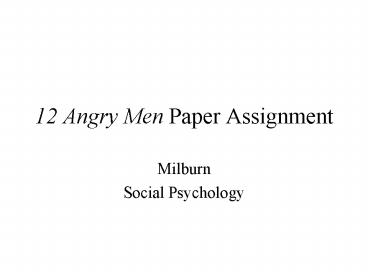12 Angry Men Paper Assignment - PowerPoint PPT Presentation
1 / 17
Title:
12 Angry Men Paper Assignment
Description:
... the study done by Elizabeth Loftus (1974, 1979), results showed that ... When Loftus presented students with a hypothetical robbery-murder case with ... – PowerPoint PPT presentation
Number of Views:1039
Avg rating:3.0/5.0
Title: 12 Angry Men Paper Assignment
1
12 Angry Men Paper Assignment
- Milburn
- Social Psychology
2
Compare and Contrast Essays
3
Writing the 12 Angry Men Paper
- The Structure of Compare and Contrast Essays
- Ways to Support an Argument
4
Compare and Contrast Essays
Introduction
Summarize 12 Angry Men
Discuss Group/Jury Research
Conclusion
5
Compare and Contrast Essays
Introduction
Summarize 12 Angry Men
Discuss Group/Jury Research
Conclusion
6
Compare and Contrast Essays
Introduction
Introduction
Summarize 12 Angry Men
Similarities Film/ Research
Discuss Group/Jury Research
Differences Film/ Research
Conclusion
Conclusion
7
Ways to support an argument
- Opinion
- Anecdote
- Research evidence
8
Ways to support an argument
- Opinion--weakest form of evidence
- Anecdote
- Research evidence
9
Ways to support an argument
- Opinion--weakest form of evidence
- Anecdote--one example also not very strong
- Research evidence
10
Ways to support an argument
- Opinion--weakest
- Anecdote--one example also not very strong
- Research evidence
- evidence based on agreed upon methodology and
peer-reviewed for publication
11
Using research evidence to support an argument
- Cite the study
- Describe the findings (briefly)
- Make the connection to example (e.g., film) being
analyzed
12
Here is a sample paragraph
In the study done by Elizabeth Loftus (1974,
1979), results showed that eyewitnesses were
believed, even when their testimony was shown to
be useless. When Loftus presented students with
a hypothetical robbery-murder case with
circumstantial evidence but no eyewitness
testimony, only 18 percent voted for conviction.
Other students received the same information but
with the addition of a single eyewitness. In
this condition, 72 percent voted for conviction.
Similarly in the movie, the stockbroker and some
others strongly believed that the boy was guilty
because the woman next door testified that she
saw the boy from her window neither of them
considered the possibility that she could be
wrong.
13
Cite the study
In the study done by Elizabeth Loftus (1974,
1979), results showed that eyewitnesses were
believed, even when their testimony was shown to
be useless. When Loftus presented students with
a hypothetical robbery-murder case with
circumstantial evidence but no eyewitness
testimony, only 18 percent voted for conviction.
Other students received the same information but
with the addition of a single eyewitness. In
this condition, 72 percent voted for conviction.
Similarly in the movie, the stockbroker and some
others strongly believed that the boy was guilty
because the woman next door testified that she
saw the boy from her window neither of them
considered the possibility that she could be
wrong.
14
Describe the findings (briefly)
In the study done by Elizabeth Loftus (1974,
1979), results showed that eyewitnesses were
believed, even when their testimony was shown to
be useless. When Loftus presented students with
a hypothetical robbery-murder case with
circumstantial evidence but no eyewitness
testimony, only 18 percent voted for conviction.
Other students received the same information but
with the addition of a single eyewitness. In
this condition, 72 percent voted for conviction.
Similarly in the movie, the stockbroker and some
others strongly believed that the boy was guilty
because the woman next door testified that she
saw the boy from her window neither of them
considered the possibility that she could be
wrong.
15
Make the connection (or clarify the difference)
In the study done by Elizabeth Loftus (1974,
1979), results showed that eyewitnesses were
believed, even when their testimony was shown to
be useless. When Loftus presented students with
a hypothetical robbery-murder case with
circumstantial evidence but no eyewitness
testimony, only 18 percent voted for conviction.
Other students received the same information but
with the addition of a single eyewitness. In
this condition, 72 percent voted for conviction.
Similarly in the movie, the stockbroker and some
others strongly believed that the boy was guilty
because the woman next door testified that she
saw the boy from her window neither of them
considered the possibility that she could be
wrong.
16
My most common comment on past papers has been
- You make some good points, but you need to
reference and discuss specific research studies. - Id like everyone to cite studies and relate the
studies to their arguments so I dont have to
make this comment on anyones paper
17
There are resources at UMB that you should take
advantage of to help your writing.































